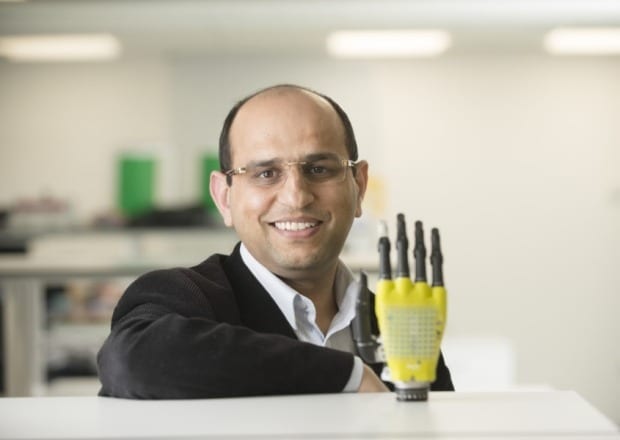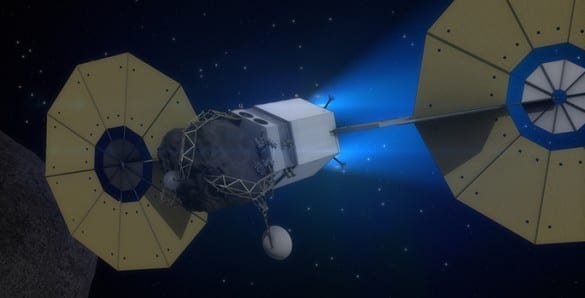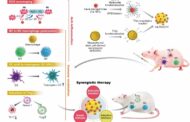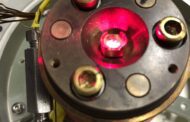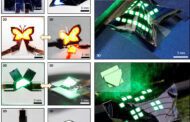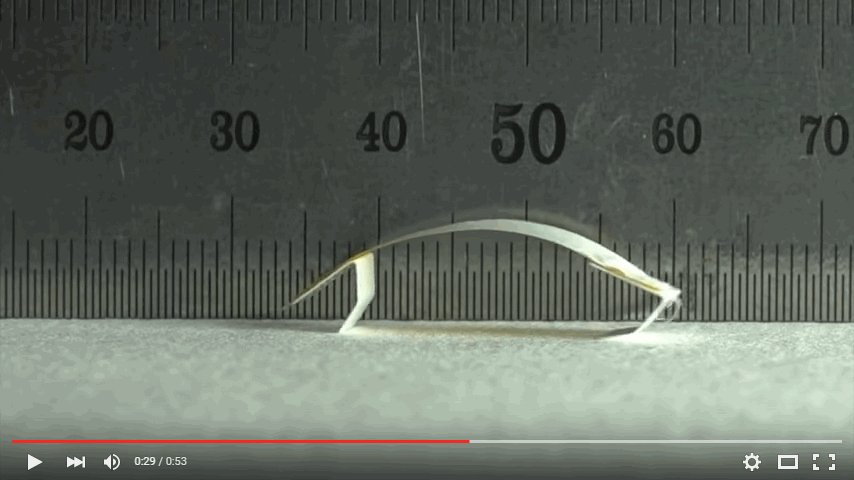
Ho-Young Kim
The Seoul National University group’s tiny plant-inspired robot moves via changes in humidity, shown here with a millimeter-scale ruler in the background.
Here come futuristic, plant-inspired microrobots that are powered simply through changes in environmental humidity — no batteries or electrical components at all
Most efforts to develop bio-inspired robots center on mimicking the motions of animals: but plants move too — even if most of their motions are so slow they can’t be detected by the naked eye.
The mechanism involved in plant movement is much simpler than that of animals using muscles. To generate motion, plants and some seeds — such as mimosa leaves, Venus flytraps and pine cones — simply harness the supply or deprival of water from plant tissues.
The future of bio-inspired engineering or robotics will greatly benefit from lessons learned from plants, according to a group of Seoul National University researchers. During the American Physical Society’s 68th Annual Meeting of the Division of Fluid Dynamics, Nov. 22-24, 2015, in Boston, they will share details about how studying plants enabled them to create tiny robots powered exclusively by changes in humidity.
The pure simplicity of the manner by which pine cones and seeds respond to changes in environmental humidity with motion is at the heart of the group’s work.
“Some seeds consist of a head that contains all its genetic information, along with a long appendage called an ‘awn’ that is responsible for locomotion — just like an animal’s sperm,” explained Ho-Young Kim, a professor in the Department of Mechanical and Aerospace Engineering at Seoul National University. “Awns are composed of two tissue layers: one that swells with humidity (active), and another that’s insensitive to humidity change (inactive).”
If environmental humidity increases, the bilayer bends from changes in length-wise swelling. Periodic humidity changes cause the bilayer to bend and unbend repeatedly — meaning that changes in environmental humidity can be converted to mechanical work.
“We mimicked the bilayer structure to make an actuator that can generate motions by using environmental humidity change,” Kim said. “Plants move slowly — one cycle of bending and unbending can take an entire day. To increase the response speed of the bilayer, we had to develop a novel way to fabricate the active layer. Its response speed increases with the surface-area-to-volume ratio of the layer because humidity can be absorbed more rapidly, so we deposited active nanoscale fibers onto an inactive layer.”
While a key step in creating a robot, repeated bending and unbending produces no net locomotion. “This cyclic motion must be converted into directional motion to create a robot that moves,” he said. “So we attached legs to our actuator, which allows only one-directional locomotion. We call the legs ‘ratchets’ and combined them with an actuator to build our bio-inspired robot.”
The group’s work is significant because it opens the door for tiny robots capable of locomotion based solely upon changes in environmental humidity — no electrical power supplies are involved. Just imagine: robots functioning in the field where no electricity is available because they operate based on changes in humidity levels in the same manner as seeds.
Sounds too easy, right? “Making a bilayer for the robots isn’t difficult, but making a fast one requires technical expertise,” said Kim. The group has also developed a mathematical model to find the optimum design for the robot to achieve the fastest speed for any given robot size.
One of the reasons why the group envisions a bright future for humidity-change-powered microrobots is because humidity changes are all around us.
“Generally, it tends to be drier during the day and more humid at night — the periodic humidity change cycle that enables seeds to bury themselves in the ground,” said Kim. “Humidity changes occur even when we breathe, because humid air is exhaled.”
Importantly for the group’s future plans, human skin is more humid than the atmosphere. “This is the main humidity gradient that we want to tap into,” he pointed out. The team is exploring the possibility of placing a tiny robot directly on human skin — one that bends because it’s humid near skin.
“The concept is that by bending, some part of the robot will move away from the skin to encounter dry atmospheric air. When it dries, the robot will return to an upright position near the skin,” he said. Then the cycle begins again, and the robot continues to move based on changes in the skin’s humidity.
Moving forward, the group’s goal is to develop these futuristic-sounding medical robots capable of functioning on human skin. Thanks to bio-inspiration from plants, “such a robot could do jobs like disinfecting wounds, removing skin wrinkles, and nourishing skin tissues,” Kim added.
Read more: Tiny Robots Inspired by Pine Cones
The Latest on: Bio-inspired robots
[google_news title=”” keyword=”Bio-inspired robots” num_posts=”10″ blurb_length=”0″ show_thumb=”left”]
via Google News
The Latest on: Bio-inspired robots
- 'The Wild Robot' Will Lumber into Theaters a Week Later Than Plannedon April 24, 2024 at 7:19 am
The Wild Robot, the next film by DreamWorks Animation, will now debut in theaters on September 27, a week later than originally planned.
- Bringing bio-inspired robots to lifeon April 22, 2024 at 11:08 am
In bringing bio-inspired robots to life, scientists must first create soft matter counterparts that match the softness and functionality of biological tissue. University of Nebraska–Lincoln ...
- Packs of dog-shaped robots could one day roam the moon — if they can find their footing on Earth firston April 19, 2024 at 10:58 am
A dog-like, bio-inspired robot called Spirit is still learning to walk, but could one day be deployed on the moon to explore steep, potentially hazardous areas with a team of robot companions.
- Video: Bio-inspired aquatic robot shoots through the water like a penguinon April 18, 2024 at 11:21 am
Penguins are fast, fantastic swimmers, so why not make an underwater robot inspired by them? That's just what German underwater tech company EvoLogics has done, with its new-and-improved Quadroin AUV ...
- Daddy long-legs-inspired robot could one day squirm through Martian caveson April 17, 2024 at 11:00 am
The spiderbot's extendable legs can grasp onto uneven rock surfaces and propel it forward.
- Project CETI develops robotics to make sperm whale tagging more humaneon April 14, 2024 at 4:59 am
Project CETI is using robotics, machine learning, biology, linguistics, natural language processing, and more to decode whale communications.
- The best robot to search for life could look like a snakeon April 3, 2024 at 12:45 pm
To deal with unknown terrain, the EELS team built a robot that could go through almost anything—a versatile, bio-inspired, snake-like design about 4.4 meters long and 35 centimeters in diameter.
- 'Smart swarms' of tiny robots inspired by natural herd mentalityon April 2, 2024 at 4:59 pm
Researchers gave nanorobots a trait called adaptive time delay, which allows them to better work together. In natural ecosystems, the herd mentality plays a major role -- from schools of fish, to ...
- Star-Wars-inspired robot rolls on a round body and uses legs to steeron March 28, 2024 at 7:49 am
Inspired by the wheel-bodied battle droids from Star Wars, a scientist has created a robot that rolls along on one big wheel, using extendable legs to steer.Instead of smashing the Rebel Alliance ...
- Latest about The Moonon March 20, 2024 at 9:25 pm
A dog-like, bio-inspired robot called Spirit is still learning to walk, but could one day be deployed on the moon to explore steep, potentially hazardous areas with a team of robot companions.
via Bing News

